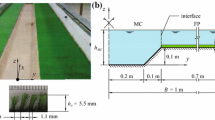Abstract
This paper presents a Reynolds stress modeling of compound open-channel flows with vegetation on the floodplain. In the Reynolds stress model, we use the SSG model by Spezialeet al., for the pressure-strain correlation term, Mellor and Herring's model for the turbulent diffusion term, and Hanjalic and Launder's model for the dissipation term. In order to take into account the anisotropy of turbulence due to the free surface, the combination of Shir's model and Gibson and Launder's model is included in the pressure-strain correlation model. Model validations are carried out for the compound open-channel flows without vegetation. Then, the model is applied to the compound open-channel flows with vegetated floodplains. The mean flow and turbulence structures are simulated and the impact of vegetation on the floodplains is investigated.
Similar content being viewed by others
References
Choi, S.-U. and Kang, H. (2001). “Numerical tests of Reynolds stress models in the computations of open-channel flows.”Proc. 8 th Symp. Flow Modeling and Turbulence Measurements, Tokyo, Japan.
Cokljat, D. and Younis, B.A. (1995) “Compound-channel flows: A parametric study using a Reynolds stress transport closure.”J. Hydr. Res., IAHR, Vol. 121, No. 2, pp. 94–107.
Gibson, M.M. and Launder, B.E. (1978) “Ground effects on pressure fluctuations in the atmospheric boundary layer.”J. Fluid Mech., Vol. 86, pp. 491–511.
Hanjalic, K. and Launder, B.E. (1972) “A Reynolds stress model of turbulence and its application to thin shear flows.”J. Fluid Mech., Vol. 52, pp. 609–638.
Kang, H. (2004). “Reynolds stress modeling of vegetated open-channel flows.” Ph.D. Thesis, Dept. of Civil Engineering, Yonsei University, Seoul, Korea.
Mellor, G.L. and Herring, H.J. (1973) “A survey of mean turbulent field closure.”AIAA Journal, Vol. 11, pp. 590–599.
Naot, D. and Rodi, W. (1982) “Calculation of secondary currents in channel flows.”J. Hydr. Div., ASCE, Vol. 108, No. HY8, pp. 948–968.
Naot, D., Nezu, I., and Nakagawa, H. (1993) “Hydrodynamic behavior of compound rectangular open channels.”J. Hydr. Engrg. ASCE, Vol. 119, No. 3, pp. 390–408.
Naot, D., Nezu, I., and Nakagawa, H. (1996) “Hydrodynamic behavior of partly vegetated open channels.”J. Hydr. Engrg., ASCE, Vol. 122, No. 11, pp. 625–633.
Pezzinga, G. (1994) “Velocity distribution in compound channel flows by numerical modeling.”J. Hydr. Engrg., ASCE, Vol. 120, No. 10, pp. 1176–1198.
Raupach, M.R. and Shaw, R.H. (1982) “Averaging procedures for flow within vegetation canopies.”Boundary Layer Meteorol, Vol. 22, p. 79.
Shimizu, Y. and Tsujimoto, T. (1993). “Comparison of flood flow structure between compound channel and channel with vegetated zone.”Proc. 25 th IAHR Congress, A-3-4, 97–104, Delft, The Netherlands.
Shir, C.C. (1973) “A preliminary study of atmospheric turbulent flow in the idealized planetary boundary layer.”J. Atmos. Sci., Vol. 30, p. 1327.
Shiono, K. and Knight, D.W. (1989). “Transverse and vertical Reynolds stress measurements in a shear layer region of a compound channel.”Proc. 7 th Symp. Turbulent Shear Flows, Stanford, Calif., 28.1.1–28.1.6.
Speziale, C.G., Sarkar, S., and Gatski, T. (1991) “Modeling the pressure strain correlation of turbulence: an invariant dynamical systems approach.”J. fluid Mech., Vol. 227, pp. 245–272.
Sofialidis, D. and Prinos, P. (1998) “Compound open-channel flow modeling with nonlinear low-Reynoldsk-ε models.”J. of Hydr. Engrg., ASCE, Vol. 124, No. 3, pp. 253–262.
Thomas, T.G. and Williams, J.J.R. (1995) “Large eddy simulation of turbulent flow in a symmetric compound open channel.”J. Hydr. Res., IAHR, Vol. 33, No. 1, pp. 27–41.
Tominaga, A. and Nezu, L. (1991) “Turbulent structure in compound open-channel flows.”J. Hydr. Engrg., ASCE, Vol. 117, No. 1, pp. 21–41.
Tominaga, A., Nezu, I., Ezaki, K., and Nakagawa, H. (1989) “Three dimensional turbulent structure in structure in straight open channel flows.”J. Hydr. Res., IAHR, Vol. 27, No. 1, pp. 149–173.
Tsujimoto, T. (1999) “Fluvial process in streams with vegetation.”J. Hydr. Res., IAHR, Vol. 37, No. 6, pp. 27–41.
Author information
Authors and Affiliations
Rights and permissions
About this article
Cite this article
Kang, H., Choi, SU. 3D numerical simulation of compound open-channel flow with vegetated floodplains by reynolds stress model. KSCE J Civ Eng 9, 7–11 (2005). https://doi.org/10.1007/BF02829092
Received:
Accepted:
Issue Date:
DOI: https://doi.org/10.1007/BF02829092



